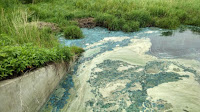Population growth and climate change over the next century will lead to a major rise in the number and severity of algae blooms in the world’s lakes, increasing global methane emissions by 30 to 90 percent, according to a new study led by the U.S. Environmental Protection Agency.
The study, published in the journal Nature Communications, examined the impacts of global population growth (an estimated 50 percent by 2100), climate change-induced flooding and runoff, and rising global temperatures on nutrient levels in the world’s lakes. It found that the extra sewage, fertilizers, and other nutrients entering waterways will increase the eutrophication of the world’s lakes by as much as 200 percent by 2050, then double or quadruple by 2100.
“It is really surprising how much eutrophication could increase in the next 50 to 100 years,” John Downing of the University of Minnesota Sea Grant program, a co-author of the new study, said in a statement. “People do four important things that affect eutrophication: they eat, they excrete, they make more people who eat and excrete, and they alter landscapes and climate.”
Eutrophication — or excess nutrient levels — causes dense algae blooms to form, which can ruin drinking water supplies and create hypoxic “dead zones” that suffocate marine life. These algae blooms are also a major source of global methane emissions — a greenhouse gas 34 times more potent than carbon dioxide in the short term. An estimated two-thirds of Lake Erie’s 130,000 kilograms of methane emitted daily during summer months, for example, is the result of algae blooms.
Read more at Worsening Algae Blooms Could Significantly Increase Global Methane Emissions

No comments:
Post a Comment